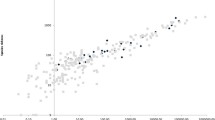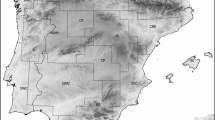Abstract
Biogeographical analyses are applied to skipper (Hesperioidea) presence/absence data from the Western Mediterranean mainland and the three largest islands (Sardinia, Corsica and Sicily) in order to identify potential conservation issues. The analyses performed on species, both collectively and individually, indicate that regional species richness and occurrence in the Mediterranean zone are largely predicted by latitude and area but that islands have impoverished faunas. Several species, predicted to be present on these islands from logistic regression of their continental distributions, are actually absent. The number of species predicted to be present from logistic regression analyses for each island, closely matched the number of species predicted to occur in regional-focused multiple regression analysis. This suggests that missing species have been identified. When compared with species that occur in Sicily and Corsica, the missing species are shown to differ for ecological traits, mainly those linked to altitudinal tolerance. No ecological distinctions were disclosed for Sardinian skippers suggesting a mainly stochastic colonisation. These results, and those from an analogous study carried out on Papilionoidea, point to Hesperioidea having (i) overall more impoverished faunas on islands and (ii) being subject to stochastic or historical colonisation events more than Papilionoidea. Species not predicted to occur on islands based on their mainland distributions and ecological traits, are foci for conservation attention. However, as many species becoming extinct on the islands may be irreplaceable, all species, in particular the Sardinian ones, deserve to be conserved.



Similar content being viewed by others
References
Balletto E, Monelli S, Cassulo L (2005) Checklist e distribuzione della fauna italiana. 10.000 specie terrestri e delle acque interne: Insecta Lepidoptera Papilionoidea (Rhopalocera). Mem Museo civico Storia Nat Verona 16:259–263+CD Rom
Baroni Urbani C (1974) Studi sulla mirmecofauna d’Italia. Le Isole Pontine. Fragmenta Entomol 9:225–252
Brusseaux G, Nel J (2004) Révision de la liste-inventaire de Charles E.E. Rungs (1988) des Lépidoptères de Corse. Revue de l’Association Rousillonnaise d’Entomologie 13:1–145
Dantart J, Stefanescu C, Avila A et al (2009) Long-distance wind-borne dispersal of the moth Cornifrons ulceratalis (Lepidoptera: Crambidae: Evergestinae) into the northern Mediterranean. Eur J Entomol 106:225–229
Dapporto L (2009) Core and satellite butterfly species on Elba island (Tuscan Archipelago, Italy). A study on persistence based on 120 years of collection data. J Insect Conserv 13:421–428
Dapporto L (2010) Satyrinae butterflies from Sardinia and Corsica show a kaleidoscopic intraspecific biogeography (Lepidoptera, Nymphlidae). Biol J Linn Soc 100:195–212
Dapporto L, Dennis RLH (2008a) Species’ richness, rarity and endemicity of Italian offshore islands: complementary signals from island-focused and species-focused analyses. J Biogeogr 35:664–674
Dapporto L, Dennis RLH (2008b) Island size is not the only consideration. Ranking priorities for the conservation of butterflies on Italian offshore islands. J Insect Cons 12:237–249
Dapporto L, Dennis RLH (2009) Conservation biogeography of large Mediterranean islands. Butterfly impoverishment, conservation priorities and inferences for an ecological “island paradigm”. Ecography 32:169–179
Dapporto L, Bruschini C, Baracchi D, Cini A, Gayubo SF, Gonzàlez JA, Dennis RLH (2009) Phylogeography and counter-intuitive inferences in island biogeography: evidence from morphometric markers in the mobile butterfly Maniola jurtina (Linnaeus) (Lepidoptera, Nymphalidae). Biol J Linn Soc 98:677–692
Dennis RLH (1997) An inflated conservation load for European butterflies: increases in rarity and endemism accompany increases in species richness. J Insect Cons 1:43–63
Dennis RLH (2000) The comparative influence of source population size and migration capacity on the persistence of butterfly species on a small offshore island. Ent Gaz 51:39–52
Dennis RLH, Shreeve TG (1996) Butterfies on British and Irish Offshore Islands. Gem Publishing Company, Wallingford
Dennis RLH, Shreeve TG (1997) Diversity of butterfly species on British islands: ecological influences underlying the roles of area, isolation and faunal source. Biol J Linn Soc 60:257–275
Dennis RLH, Shreeve TG, Olivier A (2000) Contemporary geography dominates butterfly diversity gradients within the Aegean archipelago (Lepidoptera: Papilionoidea, Hesperioidea). J Biogeog 27:1365–1384
Dennis RLH, Hodgson JG, Grenyer R et al (2004) Host plants and butterfly biology. Do host plant strategies drive butterfly status? Ecol Entomol 29:12–26
Dennis RLH, Shreeve TG, Isaac NJB et al (2006) The effects of visual apparency on bias in butterfly recording and monitoring. Biol Conserv 128:486–492
Fattorini S (2009) Both Recent and Pleistocene geography determine animal distributional patterns in the Tuscan Archipelago. J Zool 277:291–301
García-Barros E, Munguira ML, Martín Cano L et al (2004) Atlas de las mariposas diurnas de la Península Ibérica e islas Baleares (Lepidoptera: Papilionoidea and Hesperioidea). Monografias S.E.A. 11:1–228
Gutierrez D, Thomas CD, Leon-Cortes JL (1999) Dispersal, distribution, patch network and metapopulation dynamics of the dingy skipper butterfly (Erynnis tages). Oecologia 121:506–517
Habel JC, Dieker P, Schmitt T (2009) Biogeographical connections between the Maghreb and the Mediterranean peninsulas of southern Europe. Biol J Linn Soc 98:693–703
Habel JC, Rödder D, Scalercio S, Meyer M, Schmitt T (2010) Strong genetic cohesiveness between Italy and North Africa in four butterfly species. Biol J Linn Soc 99:818–830
Hanski I (1999) Metapopulation ecology. Oxford University Press, Oxford
Higgins LG, Riley ND (1983) A field guide to the butterflies of Britain and Europe. Collins, London
Hill JK, Thomas CD, Lewis OT (1996) Effects of habitat patch size and isolation on dispersal by Hesperia comma butterflies: implications for metapopulation structure. J Anim Ecol 65:725–735
Karsholt O, Razowski J (1996) The Lepidoptera of Europe. A Distributional Checklist, Apollo Books, Stenstrup
Kudrna O (2002) The distribution atlas of European butterflies. Oedippus 20:1–343
Lafranchis T (2000) Les papillons de jour de France. Belgique et Luxembourg et leurs chenilles, Collection Parthénope, Mèze
McPherson JM, Jetz W (2007) Effects of species’ ecology on the accuracy of distribution models. Ecography 30:135–151
Meulenkamp JE, Sissingh W (2003) Tertiary palaeogeography and tectonostratigraphic evolution of the Northern and Southern Peri-Tethys platforms and the intermediate domains of the African-Eurasian convergent plate boundary zone. Palaeogeogr Palaeocl 196:209–228
Parenzan P, Porcelli F (2006) I Macrolepidotteri italiani. Fauna Lepidopterorum Italiae (Macrolepidoptera). Phytophaga 15:1–393
Tolman T, Lewington R (1997) Butterflies of Britain and Europe. Harper Collins, London
Whittaker RJ (1998) Island biogeography: ecology, evolution, and conservation. Oxford University Press, Oxford
Whittaker RJ, Araujo MB, Jepson P et al (2005) Conservation biogeography: assessment and prospect. Divers Distrib 11:3–23
Williamson MH (1981) Island populations. Oxford University Press, Oxford
Acknowledgements
Our grateful thanks to two anonymous referees for their useful suggestions.
Author information
Authors and Affiliations
Corresponding author
Electronic supplementary material
Below is the link to the electronic supplementary material.
Rights and permissions
About this article
Cite this article
Dapporto, L., Dennis, R.L.H. Skipper impoverishment on large West Mediterranean islands (Lepidoptera Hesperioidea): deterministic, historical and stochastic factors. Biodivers Conserv 19, 2637–2649 (2010). https://doi.org/10.1007/s10531-010-9863-4
Received:
Accepted:
Published:
Issue Date:
DOI: https://doi.org/10.1007/s10531-010-9863-4




